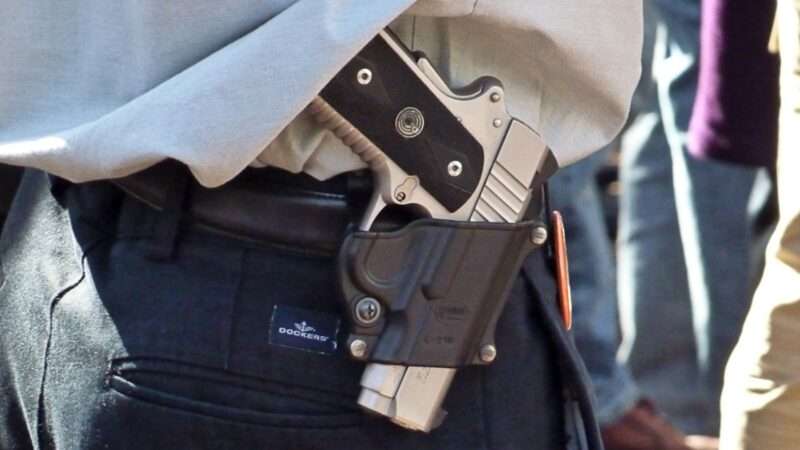
California’s sweeping restrictions on public gun possession are on hold again.
The new rules had taken effect on January 1, thanks to an adminstrative stay issued by the U.S. Court of Appeals for the 9th Circuit. But on Saturday, the appeals court dissolved that stay in May v. Bonta, allowing the preliminary injunction that U.S. District Judge Cormac Carney granted on December 20 to take effect. That means Californians with carry permits can now use them without risking prosecution for entering the state’s newly created gun-free zones, which cover most public places.
Senate Bill 2, which Gov. Gavin Newsom signed into law on September 26, “turns nearly every public place in California into a ‘sensitive place,’ effectively abolishing the Second Amendment rights of law-abiding and exceptionally qualified citizens to be armed and to defend themselves in public,” Carney noted when he issued the injunction. “California will not allow concealed carry permitholders to effectively practice what the Second Amendment promises. SB2’s coverage is sweeping, repugnant to the Second Amendment, and openly defiant of the Supreme Court.”
Carney was referring to the Supreme Court’s 2022 ruling in New York State Rifle & Pistol Association v. Bruen, which upheld the right to carry guns in public for self-defense. S.B. 2 effectively nullifies that right by prohibiting guns in 26 categories of “sensitive places,” including parks, playgrounds, zoos, libraries, museums, banks, hospitals, houses of worship, public transportation, stadiums, athletic facilities, casinos, bars, and restaurants that serve alcohol. The list also covers any “privately owned commercial establishment that is open to the public” unless the owner “clearly and conspicuously posts a sign at the entrance” saying guns are allowed.
New York, New Jersey, Maryland, and Hawaii have attempted the same end run around Bruen, making carry permits easier to obtain but much harder to use. Like California’s law, those states’ location-specific gun bans prompted litigation that resulted in federal injunctions.
Thanks to the 9th Circuit’s stay, “the Second Amendment-protected right to carry a firearm outside of the home has been effectively destroyed in California for all people with concealed carry weapon permits,” the plaintiffs in May v. Bonta said in their motion for reconsideration of the stay. Their lawyer, C.D. Michel, noted that permit holders could “no longer carry their handguns in any public place except some streets, sidewalks, and at the few private businesses that have posted signs affirmatively allowing carry on their private premises.”
By allowing S.B. 2 to take effect, Michel said, the appeals court departed from its usual practice of using administrative stays to maintain the status quo until a case can be considered on the merits. “California’s attempt to defy the U.S. Supreme Court…interrupts the status quo ante of ‘where’ people with carry permits can exercise their right to armed self-defense,” he noted.
Michel suggested that the 9th Circuit would not have issued such a stay if California had passed a law that impinged on other civil liberties. “From a constitutional law perspective, the position that Plaintiffs find themselves in because of the administrative stay allowing SB 2 to go into effect is no different than if the State had passed a law banning protest in most public spaces,” Michel wrote. “Despite a district court agreeing that such a law upset the status quo of allowing peaceful public protest and inflicted a grave First Amendment injury on hundreds of thousands of citizens, protests against an unpopular war or a corrupt politician would then nonetheless be put on hold for months or longer while the State’s emergency stay motion defending the law received more vetting by the appellate court.”
That outcome, Michel said, would be “patently unacceptable.” The fact that “the same sort of pause on the Second Amendment right is now being entertained in this case,” he argued, “lends unfortunate credence to concerns that despite the Supreme Court’s unambiguous holding to the contrary, the Second Amendment is still considered a second-class right in this Circuit.”
Michel also noted that the 9th Circuit had chosen not to stay a preliminary injunction against Hawaii’s law in Wolford v. Lopez. “Pending the outcome of the Wolford appeal, Hawaiians are not subject to the restrictive new law, and the pre-law status quo remains in effect,” he wrote. “Hawaii’s post-Bruen carry restrictions on newly-designated sensitive places remain unenforceable pending appeal, while California’s post-Bruen carry restrictions on newly-designated sensitive places are inexplicably enforceable pending appeal. The reasons for these differing outcomes and interpretations of what would preserve the status quo for one state’s citizens but not the other’s are not readily apparent, and seem to be logically irreconcilable.”
The 9th Circuit evidently thought Michel had a point. But that does not necessarily mean the appeals court, which historically has been highly sympathetic to gun control, will agree with Carney’s assessment of S.B. 2. Oral arguments in May v. Bonta are scheduled for April.
The post 9th Circuit Temporarily Restores the Right To Bear Arms As It Mulls California's New Gun-Free Zones appeared first on Reason.com.
from Latest https://ift.tt/bfyidmO
via IFTTT